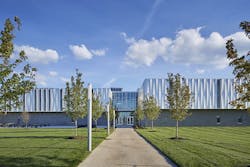Campus Serves High School and College Students in One State-of-the-Art Space
In Lee’s Summit, Missouri, located about 20 miles outside of Kansas City, a different kind of school campus welcomed its first students in 2017.
Dubbed the Missouri Innovation Campus (MIC), the school serves both high school and college-aged students (from about ages 16 to 30) who are pursuing accelerated degree programs, made possible by a partnership between the University of Central Missouri, Metropolitan Community College and Lee’s Summit R-7 School District.Designing for Two Types of Students
Architecture and design firms DLR Group and Gould Evans had to figure out how to combine university-level and high school-level education environments into one space that benefited both student bodies.
The initial idea was to separate the high school and college students—but that changed after speaking to many of the stakeholder groups, including students, adult learners and business partners in the area who offer internships.
[Related: What Trends are Driving Campus Master Planning]
“That informed us that we needed it to be more of a business-like environment as opposed to only a school environment,” says Kevin Greischar, principal at DLR Group. “That mash-up of school and business and higher-ed learning—the space has taken on more of that character.”
One of the main goals of the MIC’s four-year program is to connect industry leaders to students as they train and develop skill sets for specific workforces. Students begin the MIC’s accelerated program in their junior year of high school, where they can take both courses required to graduate from high school, as well as college credit courses to obtain an associate’s degree. The remaining two years are then spent completing their bachelor’s degree, in subjects that include engineering, computer science and cybersecurity.
[Related: New Texas STEM School Honors NASA Legend Katherine Johnson]
The campus comprises many collaborative open spaces in between its 60 classrooms where students and faculty can interact. Across two floors, the building is broken up into quadrants for different subject matters, such as health sciences and networking/software. The design strategy is meant to reflect a workplace to give students professional, real-life experience.
“The freedom for students to flow back and forth [between classrooms and common spaces] was a big focus while designing,” says Greischar. “Students working at the high school level can peer in on things happening at the college level and start thinking about next steps.”
Daylight is prominent throughout the campus, especially in the common areas, since many classrooms are without windows. Glazing on the south side of the building diffuses the natural light to make it more even and reduce glare.
The Future of Education Design
Greischar says the MIC is an ideal space for students who are struggling with a traditional learning environment. Business and industry partners in the area, such as engineering firms, are often welcome at the MIC to engage students on their plans after completing their program—and to give glimpses into what their future can hold.
“What really makes this place run is the professional, cool vibe that the students get when they come here,” Greischar says, adding: “I think it’s a look into what the future of education can be,” he says. “It’s all very hands-on. It’s about engaging students as much as we can.”
Read Next: How to Bring Children’s Library Design Into the 21st Century

